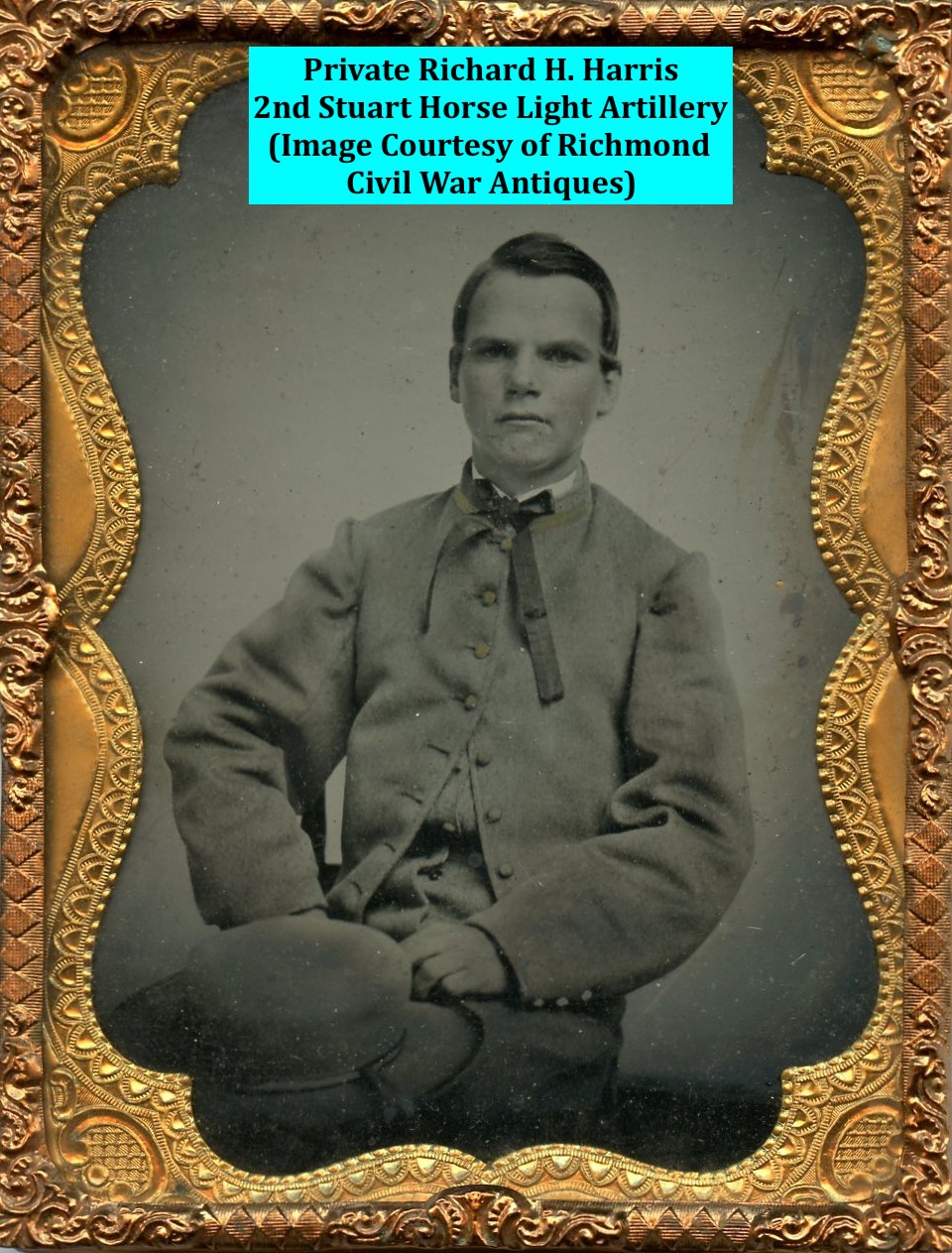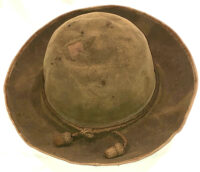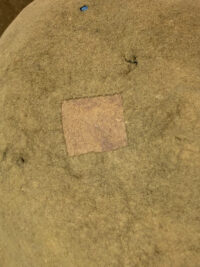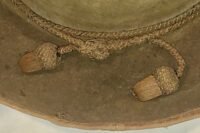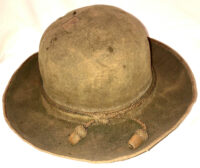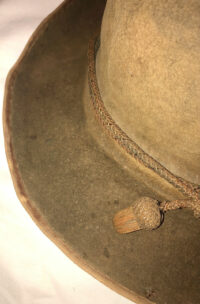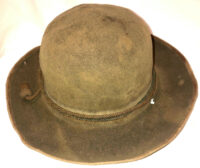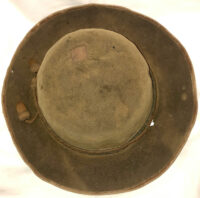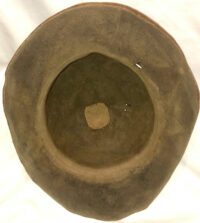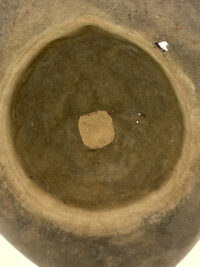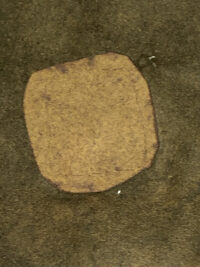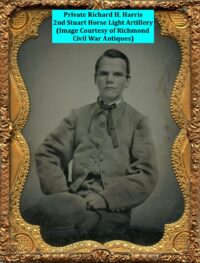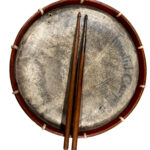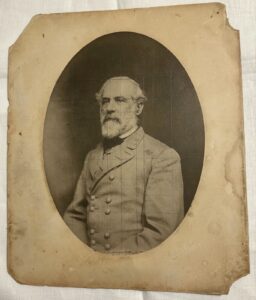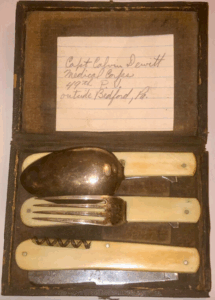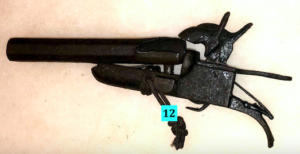Superior Example of an Identified Confederate Beehive Style Slouch Hat – Capt. Willis C. Bright Co. E 8th Tennessee Infantry
$25,000
Superior Example of an Identified Confederate Beehive Style Slouch Hat – Capt. Willis C. Bright Co. E 8th Tennessee Infantry – We have had several examples of Confederate headgear, but this hat is perhaps the best example we have possessed; the beehive style, slouch hat is the quintessential Confederate, enlisted and officer hat, seen in many period images. We obtained this hat from a long-time image collector, who retained the spectacular, accompanying image of Capt. Bright, when he enlisted in the 8th Tennessee Infantry, at the age of 17, as a Corporal. (This image is depicted with the photos of the hat, listed here.) The hat had been gifted, several decades ago, by Bright’s granddaughter, to a small museum entity, in Tennessee; a copy of a letter, written by Bright’s daughter, identifying the image and hat, to her daughter, the granddaughter of Captain Bright, is included with this fine hat; the letter states the following, mentioning Capt. Bright’s image and hat:
Transcription:
“This is your grandfather Bright. (Willis Collins) taken when he entered the Confederate Army and this is his new equipment. He was 16 yrs old. Mother said she used to laugh at him about his two big pistols and his meek expression! He may have looked meek but he fought through the entire war except for the last nine months when he was wounded in the thigh by a minnie ball, had gangrene, almost lost his life and was never able to take up arms again. That he fought valiantly, we know, he was made a Capt. after the battle of Murfreesboro when all but one, I think of the officers were killed. At that battle four color bearers were killed one after the other and he was the fifth one to catch up the colors and carry them into battle. He was one of Gen. Lee’s couriers for a time too. We have the little testament he carried throughout his service and his hat that is full of bullet holes.”
Cara Arnold, working at The Horse Soldier, did extensive research on Capt. Bright; some of her conclusions from her analysis of the note:
- Note reads: This is your grandfather Bright. (Willis Collins) taken when he entered the Confederate Army and this is his new equipment. He was 16 yrs old.
Age at enlistment: . CMSR (Compiled Military Service Record). shows that he enlisted May 18, 1861. Bright’s headstone shows a birthdate of March 17, 1844. At his enlistment, he was 17 years old.
- Note reads: He may have looked meek but he fought through the entire war except for the last nine months when he was wounded in the thigh by a minnie ball, had gangrene, almost lost his life and was never able to take up arms again.
Did he fight through the entire war? W.C. Bright enlisted May 18, 1861. His discharge date is unknown. There is no muster out on file in his CMSR (Compiled Military Service Record). The last record in the CMSR shows that Capt. Bright is granted 30 days leave of absence on a surgeon’s certificate dated January 19, 1865. As of this date, he is still mustered into the service of the 8th Tennessee Infantry. However, we can assume that since he has been in hospital and then on leave, that he likely does not return to active service, which means that he did not serve out the last 10 months of the war due to his being wounded as stated in the note.
No medical records could be located for Captain Bright. There is only one reference to him being wounded on page 11. There are no details regarding his wounding. We only know that the wounding takes place on July 22, 1864 from the recorded date on the record. The inspection report of September 1864 lists Bright “sick in hospital.” We can safely assume he is recuperating from his July wounding. Again, as there are no medical records to show what the details of Bright’s wounding and recovery are, we do not know for certain if he had gangrene and was close to death as the note states.
In a short biographical description of W.C. Bright, it mentions that he was wounded in the leg, but no actual documentation could be found to support that.
- Note reads: That he fought valiantly; we know that he was promoted to the rank of Captain, after the Battle of Mufreesboro_when all but one of the officers were killed.
Bright’s CMSR shows that he was mustered into service at the rank of corporal in May 1861. On July 16, 1862, he was appointed to the rank of 2nd lieutenant of company E. Bright was promoted to the rank of captain on June 25,1864, which was less than one month before the Battle of Atlanta, which took place July 22, 1864.
- Note reads: At that battle all of the color bearers were killed one after the other and he was the fifth one to catch up the colors and carry them into battle.
In this case, the color bearers could not be verified. No documentation of any kind could be found to verify color bearers at the Battle of Atlanta for the 8th Tennessee Infantry.
- Note reads: He was one of Gen. Lee’s couriers for a time too.
Bright’s service record states that he was on detached service beginning August 31 through December 31, 1862. He was also absent in January and February of 1863 detailed to report to General Pillow, where he was a messenger during the Battle of Stones River, also known as the Battle of Murfreesboro, (December 31, 1862-January 2, 1863). There is no evidence that Bright was ever detailed to General Lee.
An overview of Capt. Bright’s life:
- How many children did he have and what were their names?
Bright married Anna Bland Bramlitt on February 14th 1872. The two had three children: John, Mary, and Judith.
John Bramlitt Bright was born in 1872. He was never married and had no children. He died within days of his mother on April 9, 1941 in St. Petersburg, Florida. He is buried in Rose Hill Cemetery in Fayetteville, Tennessee, where both his mother and father are also buried.
Mary Bright was born January 7, 1874. She never married nor had any children. She worked for 28 years as a librarian in St. Petersburg, Florida. However, she died at the home of her younger sister, Judith, in Knoxville, Tennessee on January 24, 1961 after complications of influenza at age 87. Mary is buried at Rose Hill Cemetery in Fayetteville.
Judith Bright, W.C. and Anna’s third child, was born October 28, 1878. Judith married Fulton Wilson on January 18, 1900 in Williamson County, Tennessee. Judith and Fulton had one child, likely named for
Judith’s elder sister, Mary. Mary was born May 8, 1909 and lived a long life until her death in 2004. Judith lived a long life as a wife and mother; she died of complications of heart disease at age 86 on February 19, 1965. Judith is buried at Rose Hill Cemetery in Fayetteville, Tennessee.
- His granddaughter’s name was Mary, who was receiving this photo from her mother. What was her mother’s name (Willis’s daughter who wrote the attached note)?
As we now know, Willis Bright’s only grandchild was Mary Bright Wilson, the daughter of his youngest daughter, Judith.
- When did he die and at what age?
Willis Collins Bright was quite young at his passing. He died of a long-standing illness November 22, 1887, making him only 43 years old when he died.
Biographical Sketch of Willis Collins Bright
- Birth: W.C. Bright was born March 17, 1844 to John Morgan Bright (1817-1911) and Judith Campbell Clark Bright (1820-1855) in Fayetteville, Lincoln County, Tennessee, where he was raised and lived out the rest of his life with a brief sojourn to Edgefield, Tennessee during his adult life.
W.C.’s father, John, was a well-known lawyer who thrived in the political world beginning in 1844. John Morgan Bright married three different times; his first wife, Judith (nee Clark), was W.C.’s mother. She died of typhoid fever in 1855 when W.C. was approximately 11 years old.
Due to John Morgan Bright’s political connections, he served as the inspector-general of Tennessee during the Civil War; he held the rank of Brigadier General and served on the staff of Isham Harris from 1861-1865.
To give some context, W.C.’s parents were well-to-do. His father was a well-known politician and lawyer whose first wife, Judith Campbell Clark, was the daughter of Susan Clark (nee Forsythe) and Kentucky governor, James Clark, elected as a Whig and served from 1836 until his death in 1839.
- Education: C. Bright began his college education after the Civil War at the University of Nashville in Nashville, Tennessee. His father had also attended the same university and had graduated in 1839 before attending law school at Transylvania University in Kentucky. A family history write-up of the Brights alludes to W.C. starting out at a teacher’s college. However, he ends up choosing to become a physician, which is when he attends medical school at the University of Nashville. W.C. graduates at the top of his class as valedictorian in 1870. Another small booklet has been uncovered showing that W.C. attended the Bellevue Hospital Medical College in New York City from 1870-1871. Reading through the booklet, it appears as though the reason for Bright’s attendance was for clinical instruction. It is unclear how long Bright attended the Bellevue Medical School or what his specialty was, if any.
- Career: W.C. Bright worked as a physician in Fayetteville, Tennessee, but it is difficult to track where and when exactly he was working. We know that he worked at Price’s Drug Store in Fayetteville around 1875 and eventually he took up shop with his brother and a man named Horace Kercheval. Not only did he work as a doctor but he also worked as a pharmacist. He and his brother John, who also worked in the practice, operated a quasi-general store/pharmacy/doctor’s office, very similar to our modern-day pharmacies, with the exception that Dr. Bright performed surgeries in those offices.
- Personal Life: Bright married Anna Bramlitt February 14, 1872. The two had three children, John Bramlitt (1872-1941), Mary (1874-1961), and Judith (1872-1965). The two daughters have no middle name according to their death certificates.
- Death: Bright died November 22, 1887, of a long-standing illness, which he fought for several months. Bright traveled for healing to Bailey Springs, Alabama, a mineral well and resort with purported healing properties (these types of resorts were quite popular at the time), for treatment and recuperation. He is buried in Rose Hill Cemetery in his hometown of Fayetteville, Tennessee.
Description of the hat: This hat, as mentioned, is a superb and extremely rare example of a Confederate, beehive style, slouch hat. The hat is constructed of a fine grade of beaver or rabbit felt that is a buff color; the felt remains soft, “mellow” to the touch and quite pliable. The brim is bound with a light brown, woven material. There may have been a grosgrain ribbon surrounding the exterior of the crown, as there is a “ghost” of the possible, original presence of a decorative surround, but this could just be a sweat stain. Surrounding the exterior of the base of the crown is an original (to the hat), Civil War officer’s, bullion, hat cord with decorative “acorns”; this hat cord exhibits distinct, field wear. The interior of the hat is unlined and does not have a sweatband. In the top of the crown, is a period repair – a brown, wool patch, handsewn as a cover for a hole; this hole may be the damage inflicted by the bullet(s) mentioned by Capt. Bright’s daughter in her letter to her daughter. The hat remains in overall, excellent condition, with a modest number of small, wear and age holes throughout.
Collins Bright in the 1860 United States Federal Census
| Name | Collins Bright | ||||||||||||||||||||||
| Age | 16 | ||||||||||||||||||||||
| Birth Year | abt 1844 | ||||||||||||||||||||||
| Gender | Male | ||||||||||||||||||||||
| Race | White | ||||||||||||||||||||||
| Birth Place | Tennessee | ||||||||||||||||||||||
| Home in 1860 | District 8, Lincoln, Tennessee | ||||||||||||||||||||||
| Post Office | Fayetteville | ||||||||||||||||||||||
| Dwelling Number | 1718 | ||||||||||||||||||||||
| Family Number | 1625 | ||||||||||||||||||||||
|
|||||||||||||||||||||||
W C. Bright
| Residence was not listed;
Enlisted on 5/15/1861 as a Corporal. On 5/15/1861 he was commissioned into “E” Co. TN 8th Infantry (date and method of discharge not given) (Estimated date of enlistment)
|
8th TN Infantry
| Organized: Camp Trousdale, Sumner County, TN on 5/27/61 Mustered Out: 4/9/65 at Smithfield, NCOfficers Killed or Mortally Wounded: 1 |
| From | To | Brigade | Division | Corps | Army | Comment |
| Aug ’61 | Dec ’61 | Donelson’s | Army of Northwest | |||
| Dec ’61 | Apr ’62 | Donelson’s | Dept of South Carolina and Georgia | |||
| Apr ’62 | Jul ’62 | Donelson’s | Cheatham’s | 1st | Army of Mississippi | |
| Aug ’62 | Nov ’62 | Donelson’s | Cheatham’s | Right Wing | Army of Mississippi | |
| Nov ’62 | Sep ’64 | Donelson’s/Wright’s/Carter’s | Cheatham’s/Brown’s | 1st | Army of Tennessee | |
| Nov ’64 | Apr ’65 | Maney’s/Carter’s | Brown’s | 1st | Army of Tennessee |
8th Regiment, Tennessee Infantry (Confederate)
OVERVIEW:
8th Infantry Regiment was organized at Camp Trousdale, Sumner County, Tennessee, in May, 1861. Its members were recruited in the counties of Smith, Overton, Lincoln, Fentress, Putnam, Jackson, Moore, and Marshall. Ordered to Virginia, the unit arrived at Huntersville in July with 887 men. Assigned to D.S. Donelson’s Brigade, it participated in Lee’s Cheat Mountain Campaign, then was sent to Port Royal, South Carolina. During the spring of 1862, it moved west, fought at Corinth, Munfordville, and Perryville, then joined the Army of Tennessee. During the war it was attached to M.J. Wright’s and Maney’s Brigade. The 8th took an active part in the campaigns of the army from Murfreesboro to Atlanta, returned to Tennessee with Hood, and saw action in North Carolina. It reported 38 casualties at Perryville, lost sixty-five percent of the 474 engaged at Murfreesboro, and took 260 into the fight at Chickamauga. During December, 1863, it totalled 233 men and 207 arms. Only a remnant surrendered on April 26, 1865. The field officers were Colonels John H. Anderson, Alfred S. Fulton, William L. Moore, and L.W. Oglesby; Lieutenant Colonels A.G. Ewing and C.C. McKinney; and Majors W.H. Botts and William G. Burford.
8th Tennessee Infantry Regiment (Confederate)
Organized May 29, 1861 in Provisional Army of Tennessee; Confederate service August 31, 1861; reorganized May 8, 1862; formed Company “D”, 1st Consolidated Tennessee Infantry Regiment; paroled at Greensboro, North Carolina May 1, 1865.
FIELD OFFICERS
- Colonels-Alfred S. Fulton, William Lawson Moore, L. W. Oglesby, John H. Anderson.
- Lieutenant Colonels-William Lawson Moore Andrew G. Ewing, John H. Anderson, Christopher C. McKinney.
- Majors-William H. Botts, Christopher C. McKinney, W. G. Burford.
All company letters were changed at the reorganization of May 8, 1862, and those shown are the letters used after reorganization, with the prior numbers indicated.
CAPTAINS
- William G. Burford, I. A. McCall, J. A. McCall, D. O. Puryear, Co. “A”, formerly “I”. Men from Smith County.
- Tim S. McHenry, James C. Chowning, W. B. Petty, Co. “B”, formerly “F”. Men from Overton County.
- M. Hall, B. E. Malear, William H. Blake, William D. Bonds, Co. “C”, formerly “B”. Men from Lincoln County.
- George W. Higgins, M. C. Shook, T. A. Yant, Co. “D”, formerly “G”. “The Norris Creek Guards.” Men from Lincoln County.
- Bane McKinney, N. M. Bearden, J. S. Brown, Co. “E”, formerly “C” “The Comargo Guards.” Men from Lincoln County.
- Calvin E. Meyers, James I. Cullom, Co. “F”, formerly “D”. Men from Overton County, some from Fentress County.
- William Gore, William Sadler, John S. Quarles, Co. “G”, formerly “K”. Men from Jackson County, some from Putnam County. A number of men from this company later enlisted in Co. “E”, 4th (Murray’s) Cavalry Regiment.
- T. Armstrong, A. J. B. Walker, J. B. Overstreet, Thomas Jefferson Davis, Co. “H”, formerly “E”. Men from Celina, Jackson County (now Clay County).
- James L. Bryant, Ben B. Bowers, James M. McAfee, Co. “I”, formerly “A”. Men from Marshall County.
- William Lawson Moore, W. J. Thrash, John D. Tolley, Moses B. Shores, Co. “K”, formerly “H”. “The Mulberry Riflemen.” Men from Lincoln and Moore Counties.
Of the field officers, Colonel Fulton, Colonel Oglesby, Lieutenant Colonel Ewing, and Major Botts were dropped from the rolls at one time or another. Colonel William Lawson Moore was killed in the Battle of Murfreesboro on December 31, 1862.
Some of the companies constituting the 8th Tennessee assembled at Camp Harris, near Winchester, Franklin County, and were mustered into state service on May 18, 1861. They moved to Camp Trousdale, Sumner County, where, with other companies, they were organized into this regiment.
The Eighth was organized at Camp Trousdale on May 2; 1861. In July, 1861, it had 887 men armed with percussion muskets. Arriving at Huntersville, Virginia, July 21, 1861, it was placed in Brigadier General Daniel S. Donelson’s Brigade, along with the 16th Tennessee, and the 1st and 14th Georgia Regiments; as part of this brigade it participated in the Cheat Mountain Campaign. The 8th and 16th Tennessee Regiments served in the same brigade organizations throughout the war.
A report from Company “K” dated January 9, 1864, stated that this company was organized April 24, 1861, at Mulberry Station, Lincoln County; was received into state service at Camp Harris, Franklin County; and organized as part of the 8th Tennessee Infantry Regiment at Camp Trousdale; mustered into Confederate service July 31, 1861 at Big Springs, Virginia. It took part in the Cheat Mountain Campaign, fought at Corinth, Mississippi, Munfordville and Perryville, Kentucky, Murfreesboro, Chickamauga and Missionary Ridge. It reported a cumulative total of nine killed, 51 wounded, 12 died of disease, 48 deserted, 28 honorably discharged, nine transferred to other commands, and two furnished substitutes who had deserted.
After the Cheat Mountain failure, the 8th and 16th, Donelson’s Brigade were sent to Port Royal, South Carolina, arriving December 16, 1861. The 8th was in a skirmish at Port Royal Ferry January 1, 1862.
April 10, 1862, Donelson’s Brigade, 1572 men, was ordered to Corinth, Mississippi, and in May the brigade consisted of the 2nd, 8th, 15th, 16th and 154th Tennessee Infantry Regiments, and Carnes’ Tennessee Battery. By June 15, 1862, the 154th had been replaced by the 51st Tennessee. By June 30, the 2nd was no longer shown as part of the brigade.
At Perryville, October 8, 1862, the brigade consisted of the 8th, 15th, 16th, 38th and 51st Tennessee Regiments. The 8th suffered 38 casualties in this battle.
On December 29, 1862, two days before the Battle of Murfreesboro, the newly organized 84th Regiment was added to the brigade, but was held in reserve during the battle. In the Battle of Murfreesboro, the 8th did valiant service in the battle, but at heavy cost, losing 306 casualties out of 474 engaged, including Colonel William L. Moore, who was killed. Lieutenant Colonel John H. Anderson replaced him, and as full colonel, commanded the regiment till after the Battle of Nashville, when he was given command of a brigade. In the Battle of Murfreesboro, the brigade captured 11 pieces of artillery and 1000 prisoners.
On April 1, 1863, Brigadier General Marcus J. Wright commanded the brigade, which was composed of the 8th, 16th, 28th, and 51st Tennessee Regiments, plus Carnes’ Battery, totaling 1698 effectives. The brigade continued to be known as Wright’s Brigade until after the Battle of Franklin, though it was commanded at various times by Colonel Anderson, of the 8th, and Colonel Carter, of the
38th. On August 10, 1863, Murray’s 22nd Infantry Battalion was added to the brigade; by this time the 8th had been consolidated into a field organization with the 28th Regiment.
At Chickamauga, September 19-20, 1863, Wright’s Brigade consisted of the 8th, 16th, 28th, 38th and Murray’s Battalion and 5lst/52nd Consolidated Infantry Regiments. At Missionary Ridge, November 24-25, 1863, the 38th had been left at Charleston. Company returns state that the regimental and company books, rolls, papers of every kind were destroyed by the enemy November 25, 1863 on the retreat from Missionary Ridge with General Wright’s Brigade wagon train. Colonel Anderson was in command of the brigade, and Lieutenant Colonel C. C. McKinney of the regiment. On December 14, 1863 the 8th reported 214 effectives. On January 20, 1864 the 8th and 28th were reported on detached duty at Atlanta, Georgia. On May 9, 1864, the 8th was present at Rocky Face, Georgia.
On December 10, 1864, the 8th, 16th, and 28th, under Colonel John H. Anderson, formed one regiment in Maney’s Brigade, commanded by Colonel Hume R. Feild. After the Battle of Nashville, December 15-16, 1864, the 8th joined General Joseph E. Johnston, in North Carolina, and was surrendered and paroled at Greensboro, North Carolina, as part of the 1st Consolidated Tennessee Infantry Regiment, under Lieutenant Colonel Oliver A. Bradshaw; this was composed of the 1st, 6th, 8th, 9th, 16th, 27th, 28th and 34th Regiments and the 24th Tennessee Infantry Battalion. The 8th Regiment formed Company “D” of this regiment.
| Name | Capt Willis Collins Bright | ||||||||||||||||||||||||||||||||||||||||||||||||||
| Gender | Male | ||||||||||||||||||||||||||||||||||||||||||||||||||
| Birth Date | 17 Mar 1844 | ||||||||||||||||||||||||||||||||||||||||||||||||||
| Birth Place | United States of America | ||||||||||||||||||||||||||||||||||||||||||||||||||
| Death Date | 22 Nov 1887 | ||||||||||||||||||||||||||||||||||||||||||||||||||
| Death Place | United States of America | ||||||||||||||||||||||||||||||||||||||||||||||||||
| Cemetery | Rose Hill Cemetery | ||||||||||||||||||||||||||||||||||||||||||||||||||
| Burial or Cremation Place | Fayetteville, Lincoln County, Tennessee, United States of America | ||||||||||||||||||||||||||||||||||||||||||||||||||
| Has Bio? | N | ||||||||||||||||||||||||||||||||||||||||||||||||||
| Father | John Morgan Bright | ||||||||||||||||||||||||||||||||||||||||||||||||||
| Mother | Judith Campbell Bright | ||||||||||||||||||||||||||||||||||||||||||||||||||
| Spouse | Anna Bright | ||||||||||||||||||||||||||||||||||||||||||||||||||
| Children | Mary Bright John Bramlitt Bright Judith Wilson
|
||||||||||||||||||||||||||||||||||||||||||||||||||
Capt Willis Collins Bright
BIRTH
17 Mar 1844
USA
DEATH
22 Nov 1887 (aged 43)
USA
BURIAL
Fayetteville, Lincoln County, Tennessee












